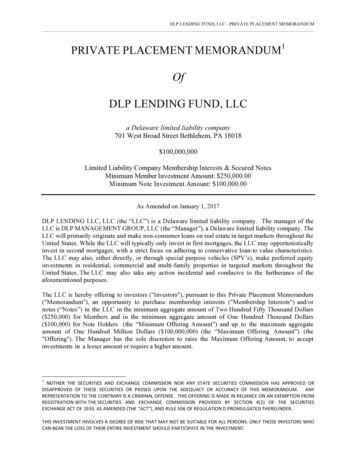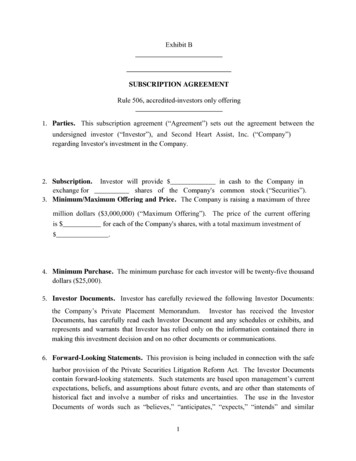
Transcription
National Security Study MemorandumNSSM 200Implications of Worldwide Population GrowthFor U.S. Security and Overseas Interests(THE KISSINGER REPORT)December 10, 1974CLASSIFIED BY Harry C. Blaney, IIISUBJECT TO GENERAL DECLASSIFICATION SCHEDULEOF EXECUTIVE ORDER 11652 AUTOMATICALLY DOWNGRADED AT TWO YEAR INTERVALS AND DECLASSIFIEDON DECEMBER 31, 1980.This document can only be declassified by the White House.Declassified/Released on 7/3/89under provisions of E.O. 12356by F. Graboske, National Security Council
CONFIDENTIAL2TABLE OF CONTENTSPagesExecutive SummaryPart One --4-17Analytical SectionChapter IWorld Demographic Trends19-34Chapter IIPopulation and World Food Supplies34-39Chapter IIIMinerals and Fuel40-49Chapter IVEconomic Development and Population Growth50-55Chapter VImplications of Population Pressures forNational Security56-65World Population Conference66-72Policy Recommendations73Section IA U.S. Global Population Strategy74-84Section IIAction to Create Conditions for Fertility Decline:Population and a Development Assistance Strategy85-105A.General Strategy and Resource for A.I.D.Assistance85-91B.Functional Assistance Programs to CreateConditions for Fertility Decline92-102C.Food for Peace Program and PopulationChapter VlPart Two --Section IIIInternational Organizations and otherMultilateral Population ProgramsA.UN Organization and Specialized AgenciesB.Encouraging Private OrganizationsCONFIDENTIAL103-105106-107
CONFIDENTIALSection IVProvision and Development of Family PlanningServices, information and TechnologyA.Research to Improve Fertility Control TechnologyB.Development of Low-Cost Delivery SystemsC.Utilization of Mass Media and SatelliteCommunications System for Family PlanningSection VAction to Develop Worldwide Political and PopularCommitment to Population StabilityCONFIDENTIAL3108-120121-123
CONFIDENTIAL4EXECUTIVE SUMARYWorld Demographic Trends1. World population growth since World War 11 is quantitatively and qualitativelydifferent from any previous epoch in human history. The rapid reduction in death rates,unmatched by corresponding birth rate reductions, has brought total growth rates close to 2percent a year, compared with about 1 percent before World War II, under 0.5 percent in1750-1900, and far lower rates before 1750. The effect is to double the world's population in 35years instead of 100 years. Almost 80 million are now being added each year, compared with 10million in 1900.2. The second new feature of population trends is the sharp differentiation between richand poor countries. Since 1950, population in the former group has been growing at O to 1.5percent per year, and in the latter at 2.0 to 3.5 percent (doubling in 20 to 35 years). Some of thehighest rates of increase are in areas already densely populated and with a weak resource base.3. Because of the momentum of population dynamics, reductions in birth rates affecttotal numbers only slowly. High birth rates in the recent past have resulted in a high proportion mthe youngest age groups, so that there will continue to be substantial population increases overmany years even if a two-child family should become the norm in the future. Policies to reducefertility will have their main effects on total numbers only after several decades. However, iffuture numbers are to be kept within reasonable bounds, it is urgent that measures to reducefertility be started and made effective in the 1970's and 1980's. Moreover, programs started nowto reduce birth rates will have short run advantages for developing countries in lowered demandson food, health and educational and other services and in enlarged capacity to contribute toproductive investments, thus accelerating development.4. U.N. estimates use the 3.6 billion population of 1970 as a base (there are nearly 4billion now) and project from about 6 billion to 8 billion people for the year 2000 with the U.S.medium estimate at 6.4 billion. The U.S. medium projections show a world population of 12billion by 2075 which implies a five-fold increase in south and southeast Asia and in LatinAmerican and a seven-fold increase in Africa, compared with a doubling in east Asia and a 40%increase in the presently developed countries (see Table I). Most demographers, including theU.N. and the U.S. Population Council, regard the range of 10 to 13 billion as the most likelylevel for world population stability, even with intensive efforts at fertility control. (These figuresassume, that sufficient food could be produced and distributed to avoid limitation throughfamines.)CONFIDENTIAL
CONFIDENTIAL5Adequacy of World Food Supplies5. Growing populations will have a serious impact on the need for food especially in thepoorest, fastest growing LDCs. While under normal weather conditions and assuming foodproduction growth in line with recent trends, total world agricultural production could expandfaster than population, there will nevertheless be serious problems in food distribution andfinancing, making shortages, even at today's poor nutrition levels, probable in many of the largermore populous LDC regions. Even today 10 to 20 million people die each year due, directly orindirectly, to malnutrition. Even more serious is the consequence of major crop failures whichare likely to occur from time to time.6. The most serious consequence for the short and middle term is the possibility ofmassive famines in certain parts of the world, especially the poorest regions. World needs forfood rise by 2-1/2 percent or more per year (making a modest allowance for improved diets andnutrition) at a time when readily available fertilizer and well-watered land is already largelybeing utilized. Therefore, additions to food production must come mainly from higher yields.Countries with large population growth cannot afford constantly growing imports, but for themto raise food output steadily by 2 to 4 percent over the next generation or two is a formidablechallenge. Capital and foreign exchange requirements for intensive agriculture are heavy, and areaggravated by energy cost increases and fertilizer scarcities and price rises. The institutional,technical, and economic problems of transforming traditional agriculture are also very difficult toovercome.7. In addition, in some overpopulated regions, rapid population growth presses on afragile environment in ways that threaten longer-term food production: through cultivation ofmarginal lands, overgrazing, desertification, deforestation, and soil erosion, with consequentdestruction of land and pollution of water, rapid siltation of reservoirs, and impairment of inlandand coastal fisheries.Mineral and Fuel8. Rapid population growth is not in itself a major factor in pressure on depletableresources (fossil fuels and other minerals), since demand for them depends more on levels ofindustrial output than on numbers of people. On the other hand, the world is increasinglydependent on mineral supplies from developing countries, and if rapid population frustrates theirprospects for economic development and social progress, the resulting instability may underminethe conditions for expanded output and sustained flows of such resources.9. There will be serious problems for some of the poorest LDCs with rapid populationgrowth. They will increasingly find it difficult to pay for needed raw materials and energy.Fertilizer, vital for their own agricultural production, will be difficult to obtain for the next fewyears. Imports for fuel and other materials will cause grave problems which could impinge on theU.S., both through the need to supply greater financial support and in LDC efforts to obtainCONFIDENTIAL
CONFIDENTIAL6better terms of trade through higher prices for exports.Economic Development and Population Growth10. Rapid population growth creates a severe drag on rates of economic developmentotherwise attainable, sometimes to the point of preventing any increase in per capita incomes. Inaddition to the overall impact on per capita incomes, rapid population growth seriously affects avast range of other aspects of the quality of life important to social and economic progress in theLDCs.11. Adverse economic factors which generally result from rapid population growth include:-- reduced family savings and domestic investment;-- increased need for large amounts of foreign exchange for food imports;-- intensification of severe unemployment and underemployment;-- the need for large expenditures for services such as dependency support,education, and health which would be used for more productive investment;-- the concentration of developmental resources on increasing food productionto ensure survival for a larger population, rather than on improving livingconditions for smaller total numbers.12. While GNP increased per annum at an average rate of 5 percent in LDCs over the lastdecade, the population increase of 2.5 percent reduced the average annual per capita growth rateto only 2.5 percent. In many heavily populated areas this rate was 2 percent or less. In the LDCshardest hit by the oil crisis, with an aggregate population of 800 million, GNP increases may bereduced to less than 1 percent per capita per year for the remainder of the 1970's. For the pooresthalf of the populations of these countries, with average incomes of less than 100, the prospect isfor no growth or retrogression for this period.13. If significant progress can be made in slowing population growth, the positive impacton growth of GNP and per capita income will be significant. Moreover, economic and socialprogress will probably contribute further to the decline in fertility rates.14. High birth rates appear to stem primarily from:a.inadequate information about and availability of means of fertility control;b.inadequate motivation for reduced numbers of children combined with motivationfor many children resulting from still high infant and child mortality and need forsupport in old age; andCONFIDENTIAL
CONFIDENTIALc.7the slowness of change in family preferences in response to changes inenvironment.15. The universal objective of increasing the world's standard of living dictates thateconomic growth outpace population growth. In many high population growth areas of the world,the largest proportion of GNP is consumed, with only a small amount saved. Thus, a smallproportion of GNP is available for investment - the "engine" of economic growth. Most expertsagree that, with fairly constant costs per acceptor, expenditures on effective family planningservices are generally one of the most cost effective investments for an LDC country seeking toimprove overall welfare and per capita economic growth. We cannot wait for overallmodernization and development to produce lower fertility rates naturally since this willundoubtedly take many decades in most developing countries, during which time rapidpopulation growth will tend to slow development and widen even more the gap between rich andpoor.16. The interrelationships between development and population growth are complex andnot wholly understood. Certain aspects of economic development and modernization appear to bemore directly related to lower birth rates than others. Thus certain development programs maybring a faster demographic transition to lower fertility rates than other aspects of development.The World Population Plan of Action adopted at the World Population Conference recommendsthat countries working to affect fertility levels should give priority to development programs andhealth and education strategies which have a decisive effect on fertility. International cooperationshould give priority to assisting such national efforts. These programs include: (a) improvedhealth care and nutrition to reduce child mortality, (b) education and improved social status forwomen; (c) increased female employment; (d) improved old-age security; and (e) assistance forthe rural poor, who generally have the highest fertility, with actions to redistribute income andresources including providing privately owned farms. However, one cannot proceed simply fromidentification of relationships to specific large-scale operational programs. For example, we donot yet know of cost-effective ways to encourage increased female employment, particularly ifwe are concerned about not adding to male unemployment. We do not yet know what specificpackages of programs will be most cost effective in many situations.17. There is need for more information on cost effectiveness of different approaches onboth the "supply" and the "demand" side of the picture. On the supply side, intense efforts arerequired to assure full availability by 1980 of birth control information and means to all (fertileindividuals, especially in rural areas. Improvement is also needed in methods of birth controlmost) acceptable and useable by the rural poor. On the demand side, further experimentation andimplementation action projects and programs are needed. In particular, more research is neededon the motivation of the poorest who often have the highest fertility rates. Assistance programsmust be more precisely targeted to this group than in the past.18. It may well be that desired family size will not decline to near replacement levelsuntil the lot of the LDC rural poor improves to the extent that the benefits of reducing family sizeCONFIDENTIAL
CONFIDENTIAL8appear to them to outweigh the costs. For urban people, a rapidly growing element in the LDCs,the liabilities of having too many children are already becoming apparent. Aid recipients anddonors must also emphasize development and improvements in the quality of life of the poor, ifsignificant progress is to be made in controlling population growth. Although it was adoptedprimarily for other reasons, the new emphasis of AID's legislation on problems of the poor(which is echoed in comparable changes in policy emphasis by other donors and by an increasingnumber of LDC's) is directly relevant to th
NSSM 200 Implications of Worldwide Population Growth For U.S. Security and Overseas Interests (THE KISSINGER REPORT) December 10, 1974 CLASSIFIED BY Harry C. Blaney, III SUBJECT TO GENERAL DECLASSIFICATION SCHEDULE OF EXECUTIVE ORDER 11652 AUTOMATICALLY DOWN-GRADED AT TWO YEAR INTERVALS AND DECLASSIFIED ON DECEMBER 31, 1980. This











